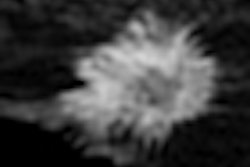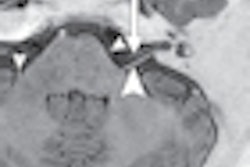Use of a specialized breast MRI scanner led to a sharp decline in false positives compared to breast imaging on whole-body MRI scanners in a study published in the October issue of Radiology. The results address what has historically been a weak point for breast MRI: its specificity.
A team led by Dr. Bruce Hillman, of the American College of Radiology's (ACR) Image Metrix clinical research organization, found a false-positive rate with dedicated breast MRI that was markedly lower than in previous studies. The current study showed 11% for all cases and 5% in the screening cohort, compared with false-positive rates that have historically been in the 32% to 41% range.
"We attribute the lower false-positive rate in our trial to a better ability to discern benign enhancement from truly malignant enhancement as a result of better spatial and contrast resolution in the dedicated system," Hillman and colleagues wrote.
Dedicated breast system
For the study, the researchers used Aurora Imaging Technology's 1.5-tesla dedicated breast MRI scanner, which has better spatial and contrast resolution than other dedicated breast MRI devices, according to Hillman and colleagues. The research was conducted under the auspices of ACR Image Metrix and was financed by Aurora (Radiology, October 2012, Vol. 265:1, pp. 51-58).
The Aurora scanner uses a protocol called SpiralRODEO (rotating delivery of excitation off resonance), a difference compared to using a whole-body MRI system for breast imaging, according to contributing author Dr. Steven Harms, who is Aurora's medical director. Whole-body systems most commonly use inversion preparation for fat suppression, "exciting" the fat and then trying to suppress it. But the RODEO protocol excites everything but fat in the tissue being imaged, Harms told AuntMinnie.com via email.
"Since fat is never excited, there are fewer artifacts, and very high contrast between fat and tumors is achieved," Harms said.
The Aurora unit also differs from other breast MRI scanners in how it acquires data, Harms said.
"Whole-body MR uses 3DFT [3D Fourier transformation] acquisition methods to reconstruct an image; the phase-encoding projections have to be acquired line by line," Harms said. "Aurora uses a spiral acquisition method that starts each line in the center of reconstruction space and spirals toward the periphery. This method is much more efficient and requires only 32 projections to calculate a 512 image. A very important part of spiral acquisitions is that the contrast-dependent portion of reconstruction space is in the center. With 3DFT only one projection goes through the center, but with spiral every projection goes through the center."
For the Radiology study, Hillman's team included 934 consecutive screening (347) and diagnostic (587) exams performed in women ages 25 to 89 years old. The exams were taken between April 2006 and December 2007 at four sites chosen for their location and practice variations:
- Breast Center of Northwest Arkansas in Fayetteville, AR
- Knoxville Comprehensive Breast Center in Knoxville, TN
- Mercy Women's Center in Oklahoma City
- University of Massachusetts Medical School in Worcester, MA
The study determined the sensitivity, specificity, and receiver operator characteristics (ROC) for breast MRI using the Aurora unit and compared these results to data from the American College of Radiology Imaging Network (ACRIN) 6883 trial, which also studied the performance of breast MRI.
The sensitivity and specificity levels for the Aurora scanner with RODEO were 92% (92 of 100) and 88.8% (741 of 834), respectively. For all cases, the negative predictive value (NPV) was 98.9% (741 of 749). The NPV for screening cases was 100% (326 of 326). The area under the ROC curve was 0.942.
In contrast, the ACRIN 6883 trial showed breast MRI sensitivity of 88%, specificity of 67%, and an NPV of 86%.
"The lack of specificity of breast MR in previous studies increases the ultimate cost of patient care by encouraging redundant testing and unnecessary biopsies, as well as potentially increasing morbidity and anxiety for the patient," Hillman's group concluded.
|
Study disclosures The study was conducted by ACR Image Metrix under contract with Aurora Imaging Technology, which provided grant support. Hillman and co-author Gary Stevens, PhD, are independent contractors for ACR Image Metrix; Harms is a stockholder and medical director of Aurora Imaging Technology and is the trial principal investigator, while co-author Dr. Lawrence Moss is the medical director of Aurora Breast MRI of Central Massachusetts. |



















